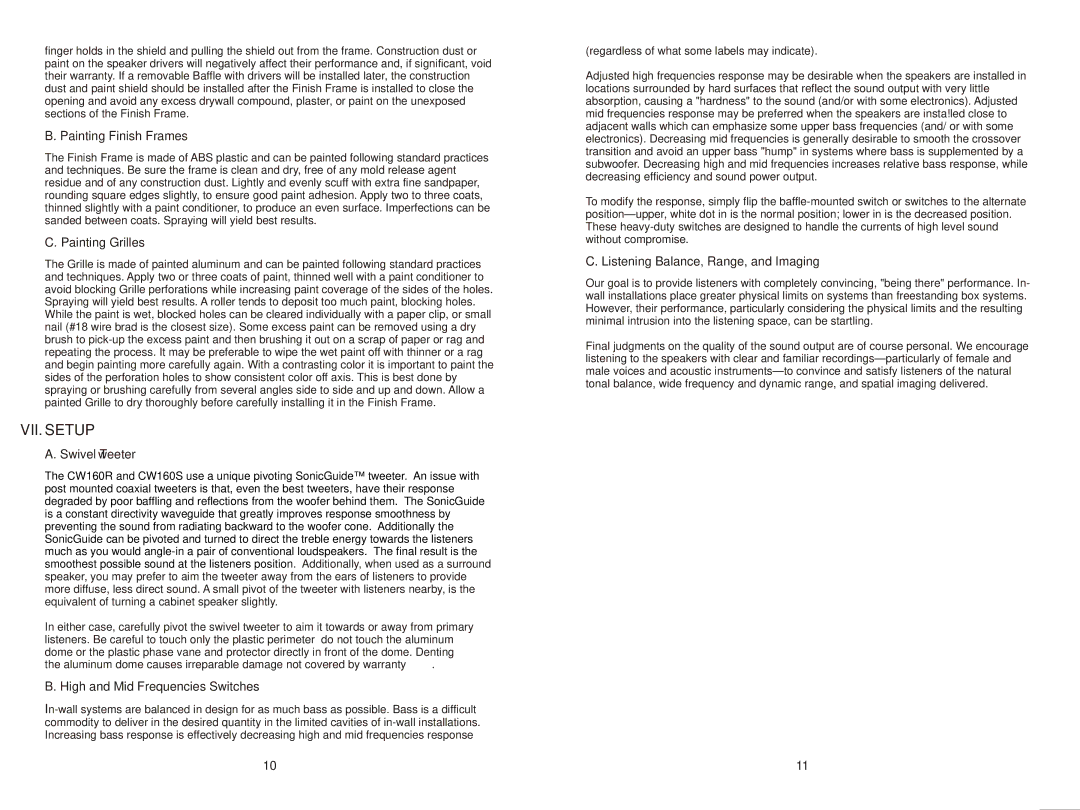finger holds in the shield and pulling the shield out from the frame. Construction dust or paint on the speaker drivers will negatively affect their performance and, if significant, void their warranty. If a removable Baffle with drivers will be installed later, the construction dust and paint shield should be installed after the Finish Frame is installed to close the opening and avoid any excess drywall compound, plaster, or paint on the unexposed sections of the Finish Frame.
B. Painting Finish Frames
The Finish Frame is made of ABS plastic and can be painted following standard practices and techniques. Be sure the frame is clean and dry, free of any mold release agent residue and of any construction dust. Lightly and evenly scuff with extra fine sandpaper, rounding square edges slightly, to ensure good paint adhesion. Apply two to three coats, thinned slightly with a paint conditioner, to produce an even surface. Imperfections can be sanded between coats. Spraying will yield best results.
C. Painting Grilles
The Grille is made of painted aluminum and can be painted following standard practices and techniques. Apply two or three coats of paint, thinned well with a paint conditioner to avoid blocking Grille perforations while increasing paint coverage of the sides of the holes. Spraying will yield best results. A roller tends to deposit too much paint, blocking holes. While the paint is wet, blocked holes can be cleared individually with a paper clip, or small nail (#18 wire brad is the closest size). Some excess paint can be removed using a dry brush to pick-up the excess paint and then brushing it out on a scrap of paper or rag and repeating the process. It may be preferable to wipe the wet paint off with thinner or a rag and begin painting more carefully again. With a contrasting color it is important to paint the sides of the perforation holes to show consistent color off axis. This is best done by spraying or brushing carefully from several angles side to side and up and down. Allow a painted Grille to dry thoroughly before carefully installing it in the Finish Frame.
VII. SETUP
A. Swivel Tweeter
The CW160R and CW160S use a unique pivoting SonicGuide™ tweeter. An issue with post mounted coaxial tweeters is that, even the best tweeters, have their response degraded by poor baffling and reflections from the woofer behind them. The SonicGuide is a constant directivity waveguide that greatly improves response smoothness by preventing the sound from radiating backward to the woofer cone. Additionally the SonicGuide can be pivoted and turned to direct the treble energy towards the listeners much as you would angle-in a pair of conventional loudspeakers. The final result is the smoothest possible sound at the listeners position. Additionally, when used as a surround speaker, you may prefer to aim the tweeter away from the ears of listeners to provide more diffuse, less direct sound. A small pivot of the tweeter with listeners nearby, is the equivalent of turning a cabinet speaker slightly.
In either case, carefully pivot the swivel tweeter to aim it towards or away from primary listeners. Be careful to touch only the plastic perimeter —do not touch the aluminum dome or the plastic phase vane and protector directly in front of the dome. Denting the aluminum dome causes irreparable damage not covered by warranty.
B. High and Mid Frequencies Switches
In-wall systems are balanced in design for as much bass as possible. Bass is a difficult commodity to deliver in the desired quantity in the limited cavities of in-wall installations. Increasing bass response is effectively decreasing high and mid frequencies response
(regardless of what some labels may indicate).
Adjusted high frequencies response may be desirable when the speakers are installed in locations surrounded by hard surfaces that reflect the sound output with very little absorption, causing a "hardness" to the sound (and/or with some electronics). Adjusted mid frequencies response may be preferred when the speakers are insta!led close to adjacent walls which can emphasize some upper bass frequencies (and/ or with some electronics). Decreasing mid frequencies is generally desirable to smooth the crossover transition and avoid an upper bass "hump" in systems where bass is supplemented by a subwoofer. Decreasing high and mid frequencies increases relative bass response, while decreasing efficiency and sound power output.
To modify the response, simply flip the baffle-mounted switch or switches to the alternate position—upper, white dot in is the normal position; lower in is the decreased position. These heavy-duty switches are designed to handle the currents of high level sound without compromise.
C. Listening—Balance, Range, and Imaging
Our goal is to provide listeners with completely convincing, "being there" performance. In- wall installations place greater physical limits on systems than freestanding box systems. However, their performance, particularly considering the physical limits and the resulting minimal intrusion into the listening space, can be startling.
Final judgments on the quality of the sound output are of course personal. We encourage listening to the speakers with clear and familiar recordings—particularly of female and male voices and acoustic instruments—to convince and satisfy listeners of the natural tonal balance, wide frequency and dynamic range, and spatial imaging delivered.
